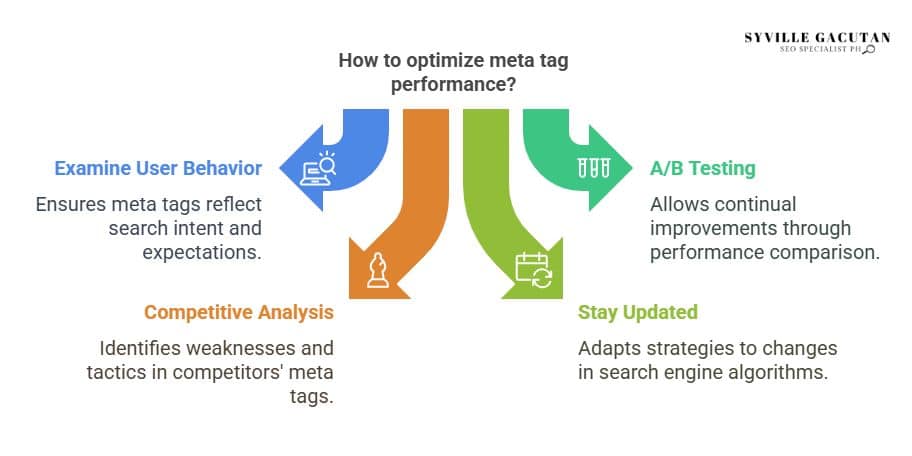
Meta tags play a key role in making your content more visible in search results. First, focus on optimizing pages for queries that get a lot of views but not many clicks, so you can capture missed opportunities. Second, make sure your meta descriptions reflect what people are actually looking for, so you meet their expectations. Third, use different tools, like analytics, to get a well-rounded view of what works. Fourth, include relevant keywords, but don’t overdo it—keep things natural and balanced. Finally, take a close look at your competition to find gaps and create meta tags that stand out. These best practices for meta tags SEO, when effectively combined, can markedly enhance your content’s performance in search results.
Key Takeaways
- Examine user behavior to ensure that meta tags appropriately reflect search intent and expectations.
- To optimize meta tag performance and make continual improvements, use A/B testing.
- To find weaknesses and tactics in competitors’ meta tags, do a competitive study.
- For adaptable meta tag techniques, stay up to date on changes to search engine algorithms.
- Use resources like Ahrefs and Google Analytics to gain knowledge about the efficacy of meta tags.

1. Optimize Pages for High-Impression, Low-Click Queries to Boost Rankings
Improving the relevancy and attractiveness of your meta tags is crucial if you want to maximize page ranks for queries with high impressions and low clicks. A thorough impression analysis can reveal which queries are attracting views but not resulting in clicks, indicating a disconnect between user intent and the perceived value of your content. Addressing this gap requires strategic adjustments to your meta tags to better align with user expectations and search intent.
Crafting effective click-through strategies begins with a deep understanding of competitive keywords. Incorporating these keywords into your meta descriptions can significantly improve visibility, but it is equally important to ensure these keywords reflect the core of what users are actively seeking. This involves a nuanced balance between keyword optimization and content relevance, ensuring that your meta tags are not only keyword-rich but also contextually meaningful.
Moreover, understanding user intent is crucial for refining meta tags that resonate with your audience. Users often seek specific answers or solutions, and your meta tags should clearly communicate how your content addresses their needs. By doing so, you can convert high impressions into meaningful clicks, improving your page’s performance and search engine ranking.
Lastly, consider employing A/B testing to refine your meta tags continually. By measuring the effectiveness of different meta tag variations, you can identify the most compelling combinations that drive higher click-through rates. This iterative process, grounded in impression analysis and aligned with the nuances of user intent, will ensure your meta tags are optimized for maximum engagement and relevance.
2. Prioritize Emotional Triggers: Make Sure It Matches Customer Needs

Enhancing meta tags to drive clicks requires more than just keyword optimization; it demands an acute understanding of user expectations. Crafting meta tags that accurately describe what customers are looking for ensures that they receive precisely what they want, thereby increasing engagement and reducing bounce rates. This process begins with a fundamental comprehension of customer intent. By analyzing why users are searching for specific terms, businesses can tailor their meta tags to better align with the expectations and needs of their target audience.
Search relevance plays a pivotal role in this strategy. Meta tags must be succinct yet comprehensive, providing a clear snapshot of the content’s value. This requires a harmonious blend of specificity and brevity, ensuring that potential visitors immediately grasp the page’s purpose. Achieving this balance enhances user experience, as it prevents mismatches between user intent and page content, which can frustrate users and deter them from engaging further.
Moreover, content alignment is crucial. The meta tag should not only reflect the keywords users are likely to search for but should also align with the actual content on the page. This alignment fosters trust and credibility, encouraging users to explore the site further.
Meta clarity, therefore, is paramount; it involves crafting a message that is both informative and engaging. By focusing on these elements, businesses ensure that their meta tags not only attract clicks but also retain users by delivering on the promises made in the search snippet. This approach ultimately leads to a more satisfied and loyal customer base.
3. Harness the Power of Diverse Resources

To create highly effective meta tags, leveraging multiple resources is crucial for gaining comprehensive insights into user behavior and preferences. This strategy enables a deeper understanding of the motivations behind user searches, leading to more accurate content alignment. Resource diversity ensures that meta tags are not only relevant but also competitive in search rankings. By examining a variety of data sources, businesses can perform thorough competitive analysis, identifying gaps in competitors’ meta tag strategies and capitalizing on those opportunities.
Understanding user intent is paramount when crafting meta tags. Utilizing tools that analyze search query data, such as Google Analytics and SEMrush, can reveal the specific needs and interests of your target audience. This data-driven approach aids in the creation of meta tags that resonate with users, driving higher engagement and click-through rates. Moreover, content alignment with user expectations is achieved by integrating insights from various resources, ensuring that the meta tags accurately reflect the content they describe.
Performance tracking, another critical aspect, involves monitoring the effectiveness of your meta tags over time. By using platforms like Moz and Ahrefs, businesses can track how well their meta tags perform in terms of search engine ranking and user engagement. This ongoing analysis allows for real-time adjustments and optimization, ensuring that meta tags remain effective.
| Resource Type | Purpose | Example Tools |
| Competitive Analysis | Identify gaps and opportunities | SEMrush, SpyFu |
| User Intent | Understand search motivations | Google Analytics, AnswerThePublic |
| Content Alignment | Match tags to user needs | BuzzSumo, SimilarWeb |
| Performance Tracking | Measure and optimize results | Moz, Ahrefs |
This multi-faceted approach ensures that meta tags are not only comprehensive but also adaptive to evolving market dynamics.
4. Include the Right Keywords – but don’t go overboard!

Strategic keyword integration is essential for crafting effective meta tags that enhance search visibility and user engagement. However, it is crucial to strike the right balance in keyword usage. Overloading meta tags with keywords can lead to keyword stuffing, which not only disrupts semantic relevance but also risks penalties from search engines.
Instead, focus on a content strategy that prioritizes meaningful keyword density, aligning with user intent and search engine algorithms.
Understanding user intent is pivotal when selecting keywords. This involves conducting a thorough competitive analysis to identify terms and phrases that accurately match what potential visitors are searching for. By focusing on keywords that resonate with user intent, businesses can ensure their meta tags are both relevant and effective.
However, it’s vital to remember that more is not necessarily better; quality trumps quantity in keyword incorporation.
For an effective approach, consider these guidelines:
- Prioritize semantic relevance: Ensure that keywords are naturally integrated and directly related to the content’s theme.
- Optimize keyword density: Maintain a balanced ratio to avoid overuse, which can lead to diminished search engine credibility.
- Align with content strategy: Use keywords that support the overall goal of your content, enhancing both structure and purpose.
5. Navigate the Competitive Landscape

Before crafting effective meta tags, it is essential to survey the existing digital landscape. This foundational step involves understanding the current meta tag trends, analyzing user behavior, and conducting thorough competitor analysis. By doing so, one can gain valuable insights that inform the creation of meta tags that are not only relevant but also effective in capturing the attention of both users and search engines.
Exploring meta tag trends is crucial, as these trends reflect the evolving preferences of search engines and users alike. Keeping abreast of these trends can help in crafting meta tags that align with contemporary demands, ensuring that content remains visible and engaging.
Similarly, analyzing user behavior provides a window into what potential visitors are searching for and how they interact with search results. This understanding can guide the selection of keywords and phrases that resonate well with the target audience, enhancing content relevance.
Competitor analysis is another pivotal aspect of surveying the digital landscape. By examining the meta tags of successful competitors, one can identify strategies that work and adapt them to fit their own content goals. This analysis also aids in differentiating one’s content, ensuring it stands out in a crowded digital space.
Lastly, an understanding of search engine algorithms is indispensable. As these algorithms continuously evolve, ensuring that meta tags remain optimized for search engine visibility is vital.
Final Thoughts
Meta tags are a powerful tool that can significantly enhance your website’s visibility and performance when used effectively. By aligning your meta tags with user intent, leveraging data-driven insights, and striking a balance between keywords and content relevance, you can improve both search engine rankings and user engagement. Staying adaptable to evolving trends and continuously refining your meta tags through testing will help keep your content competitive and visible.
Need help optimizing your meta tags for better search visibility? Connect with Syville Gacutan, an SEO Specialist in the Philippines. Syville can help you craft compelling meta tags, refine your SEO strategy, and drive more targeted traffic to your website. Reach out today and take your SEO to the next level!